-
Car Reviews
- All reviews
- Midsize SUVs
- Small cars
- Utes
- Small SUVs
- Large SUVs
- Large cars
- Sports SUVs
- Sports cars
- Vans
Latest reviews
- Car News
-
Car Comparisons
Latest comparisons
- Chasing Deals
The first-ever Kona Hybrid is here! Is it the sweet spot in the new Kona lineup and does it justify its $4000 price premium?
Let’s play a game of word association. If I say ‘Hyundai’, there’s a high chance you might respond with: ‘i30’.
That’s not surprising. At the time of writing this review, the Hyundai i30 is just clinging to its position as Hyundai Australia’s top-selling nameplate. It’s a position the venerable small car has held for over a decade.
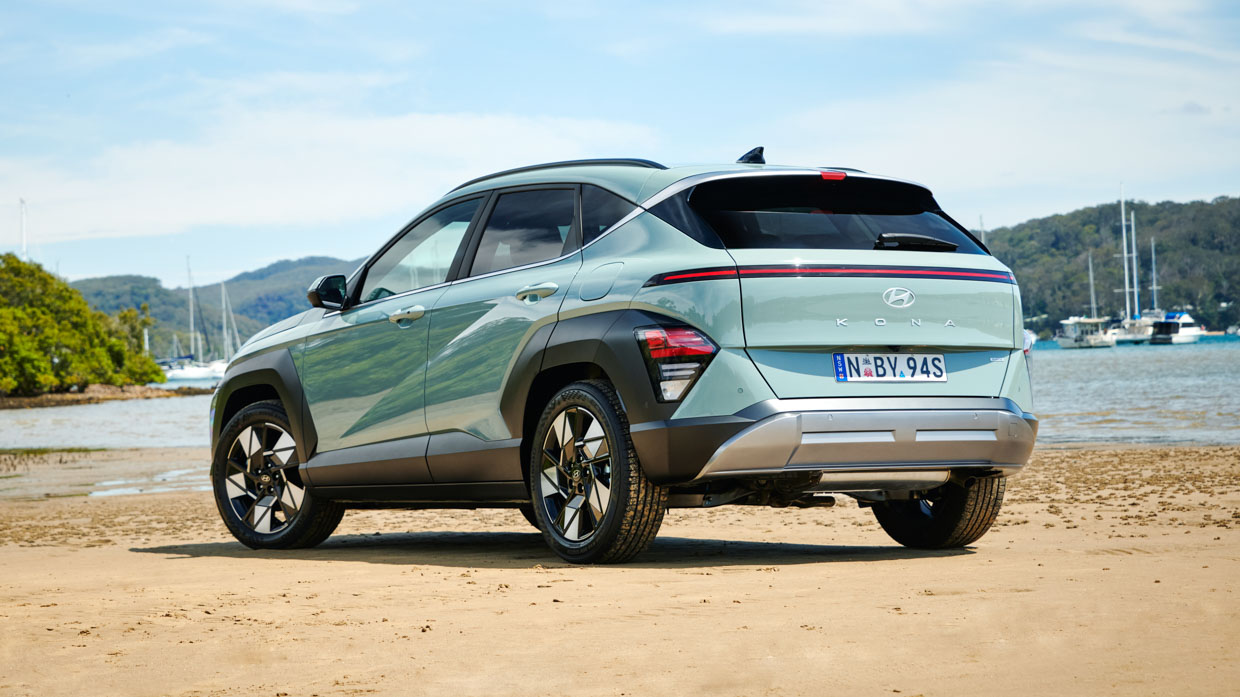
But those days are numbered. A new, higher-riding successor casts a looming shadow over its sibling, and chances are that if we played that same game in a year or two, you might instead respond with the word… ‘Kona’.
Changing consumer tastes – read: SUV-mania – all point to the Kona eventually inheriting Hyundai’s sales crown, with the Korean brand open about the fact that the just-launched, new-generation small SUV will eventually be its highest-selling vehicle in Australia, even ahead of its big-selling Tucson midsize SUV.
And so, the new Kona plays a pivotal and brand-defining role for the Korean marque as it navigates further into an SUV-dominated and carbon-reduced era.
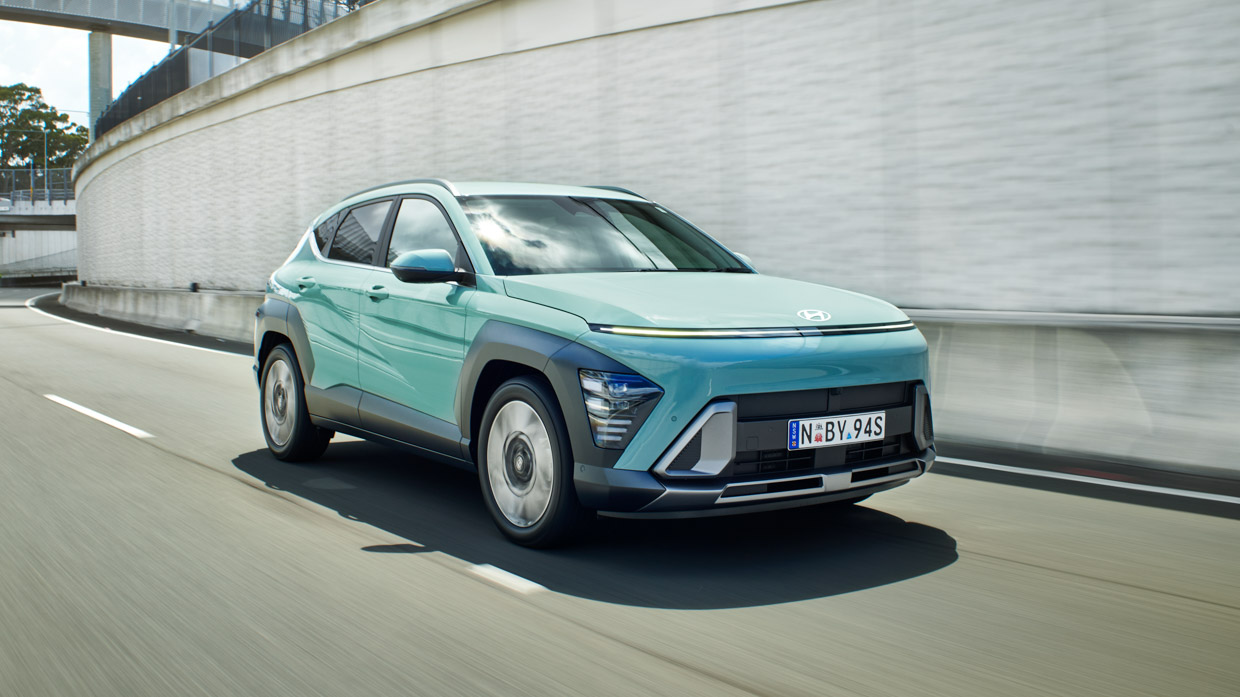
Significantly, the second-generation Kona is the first Hyundai to be available with petrol, electric, and hybrid powertrain options. Moreover, Hyundai also says that the vehicle was designed as an EV first before being re-worked for its ICE and hybrid powertrain versions.
While the EV will no doubt attract significant attention when it launches in Australia by year’s end, it’s the hybrid – already making up 34 percent of Kona orders – that Hyundai says will be the highest-volume seller and soon overtake the petrol as consumers look to more fuel-efficient options.
Bigger, safer, techier and arguably more stylish than the generation it replaces, the new-generation Kona can boast many positive attributes over its predecessor, but it’s the hybrid variant that can boast all of that plus significant fuel-savings over its petrol counterparts. For a price.
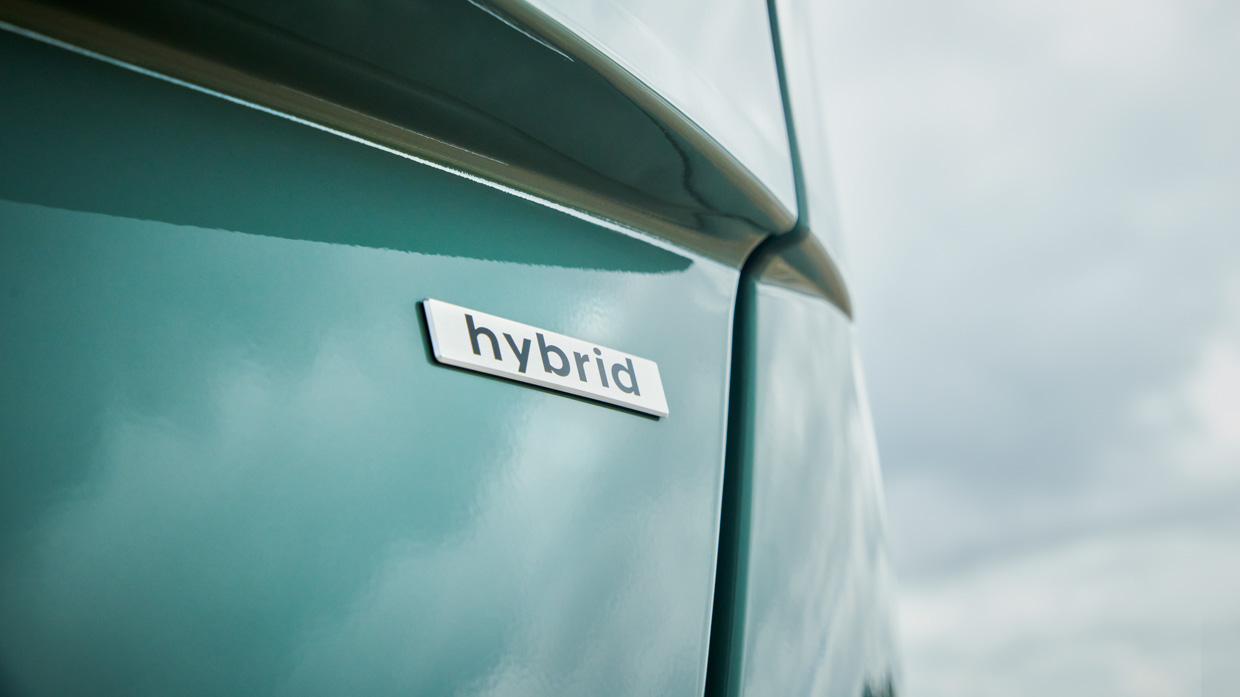
We’ve been waiting to test drive it with great interest and have even previously speculated in our review of the turbo-petrol Kona N-Line, whether the Premium Hybrid – the model we have on test today – could be the sweet spot in the range.
So, is it? Does it have the ammo to justify its price premium and climb the sales charts in the way Hyundai desires? And how does it stack up as an attainable, fuel-efficient small SUV?
Whether it be trim, powertrain, or drivetrain, the new Kona offers a plethora of choices for buyers.
Prices start at $32,000 and peak at $46,500 before on-roads costs, at least until the electric Kona arrives.
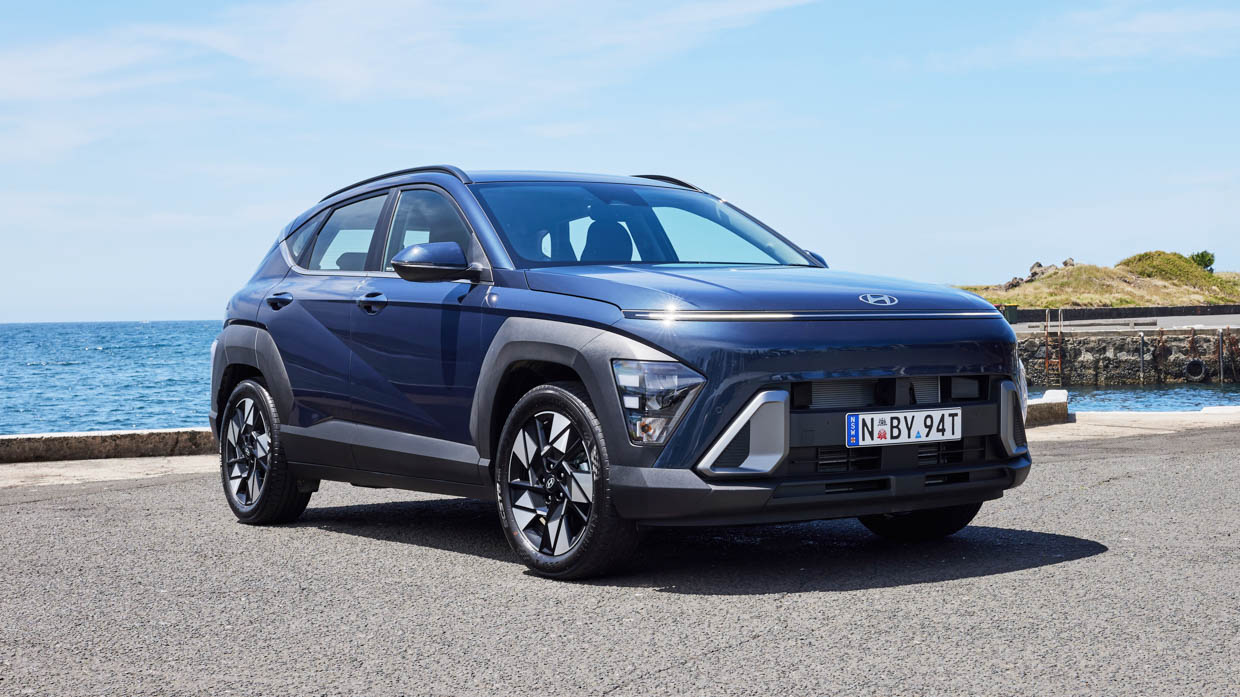
Pictured: the base model Kona hybrid
There are two main grades of Kona – the regular entry-level model, and the Premium. Both can then be optioned with an N-Line package for those who desire a sportier flavour.
Within that lineup you have a choice of three four-cylinder powertrains – a naturally aspirated 2.0-litre, the 1.6-litre hybrid on test, or a 1.6-litre turbo-charged engine – the latter only available with the N-Line package and offered exclusively with all-wheel drive, unlike its front-wheel-drive-only siblings.
Interestingly, all three engine choices come with different approaches to their automatic transmissions – a CVT for the 2.0-litre, an eight-speed torque converter for the turbo, and a six-speed dry dual-clutch unit for the hybrid.
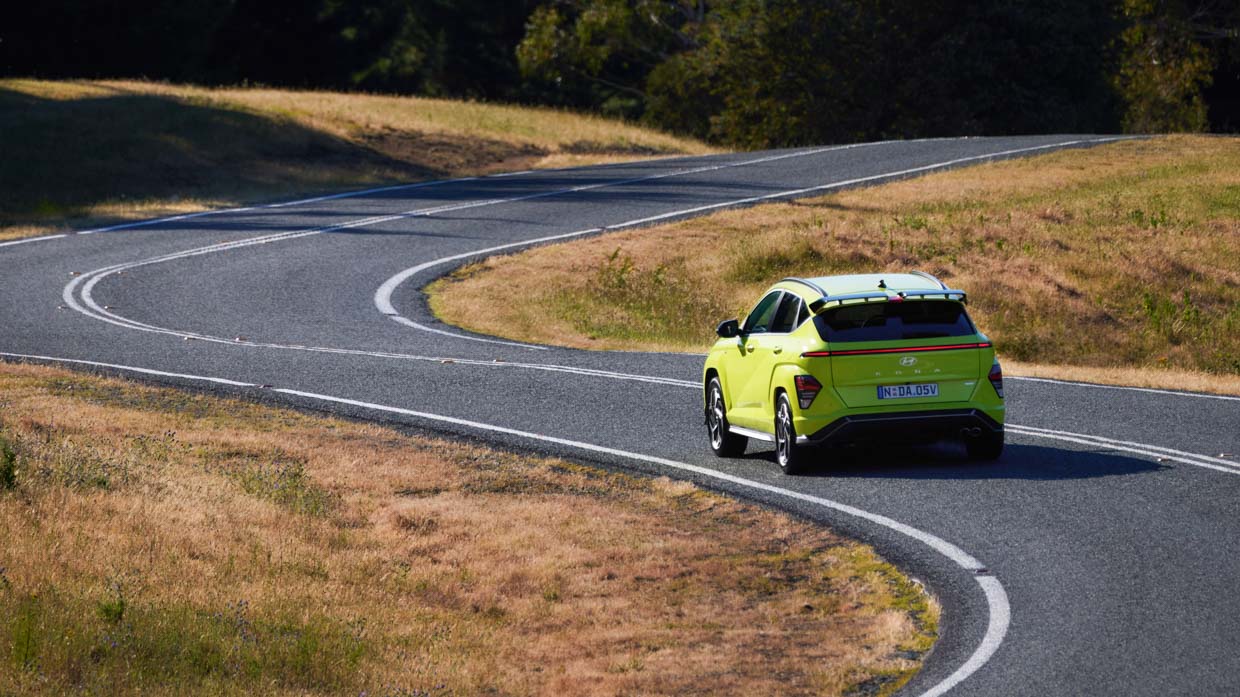
Pictured: the Kona Hybrid with the N Line package fitted
It’s the 2.0-litre that opens the range at $32,000 before on-road costs and you’ll need an additional $4000 to get yourself access to a hybrid.
From there it’s a further additional $4000 to option the hybrid with the N-Line package, or an additional $7300 to step up to the Premium we are testing today priced at $43,500 before on roads.
Of course you could also go a step further and option the Premium with the N-Line package for an additional $3000 on top of that, or you can wait for the electric – but pricing has not yet been confirmed for that one.
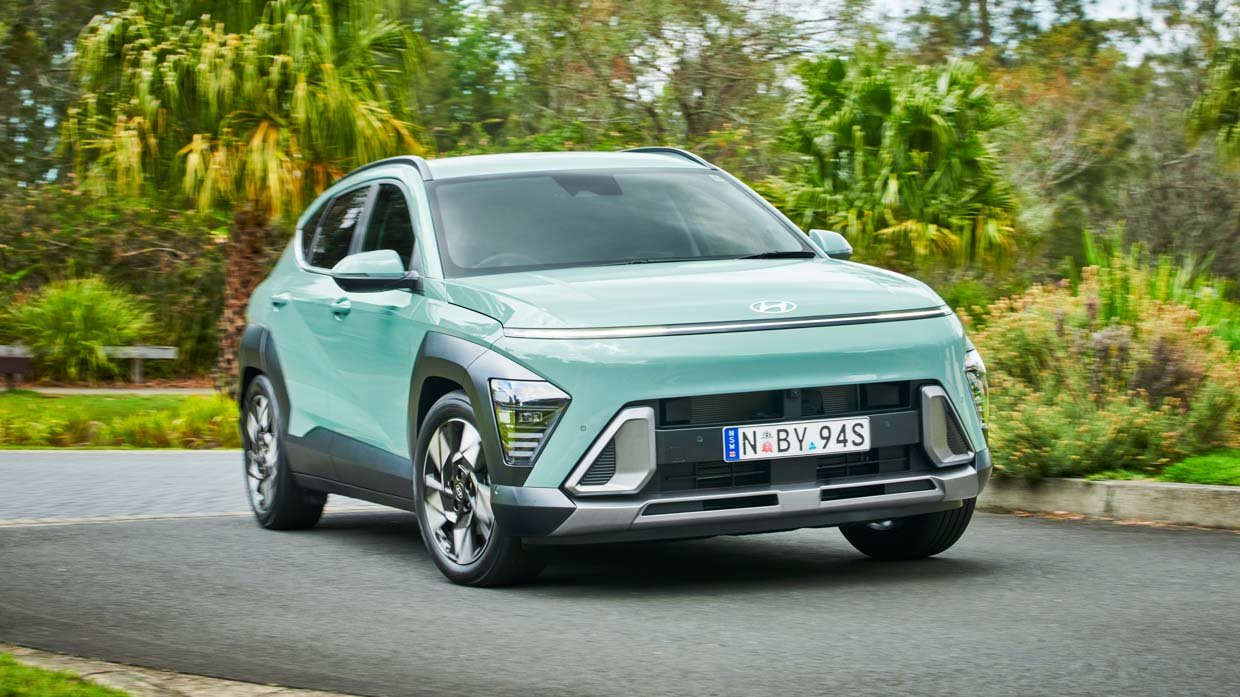
So is stepping up the range worth it? The additional asking price for both the Hybrid and Premium Hybrid variants may seem steep initially, but you are getting a suite of additional features and tech for the privilege.
The Kona already comes standard with a host of standard tech and safety features for the entry-level:
18-inch alloy wheels
Stepping up from the 2.0-litre base model to the Hybrid brings with it:
As well as the additional features above, you’re also getting more torque by choosing the hybrid. While the hybrid’s 104kW powertrain is similar to the 2.0-litre’s 110kW, the hybrid matches the turbo’s 265Nm of torque, comfortably eclipsing the 2.0-litre’s 180Nm.
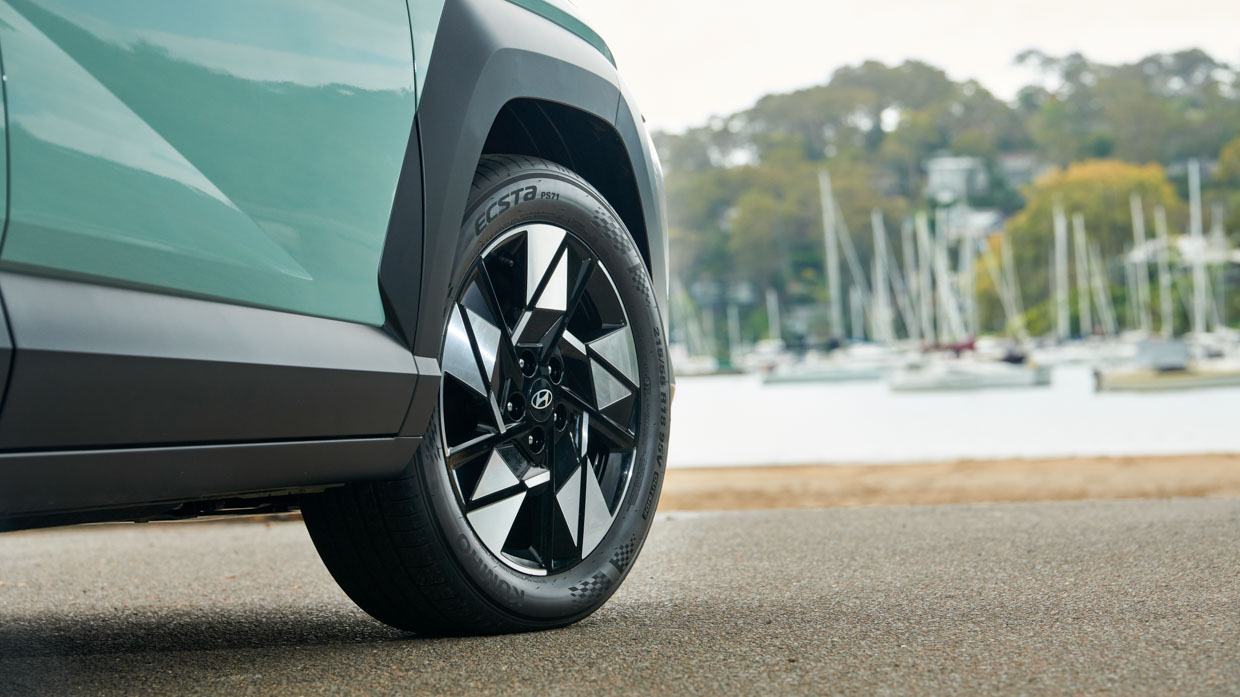
Stepping up to the Premium Hybrid trim then also brings with it:
The Premium also unlocks the option for a glass sunroof, power sunshade, and cloth knit headlining.
We’ll tackle safety features a bit further along in the review, as well as the important question of whether the Hybrid and additional features above are worth the additional cost.
Inside the new Kona Hybrid Premium you are greeted with familiar design elements from other contemporary Hyundai models. That includes the prominent dual 12.3-inch screens housing the driver instrument displays and infotainment.
The graphics for the digital driver instrument display are clean, simple and easy to read. Likewise, the media display is a slick unit with intuitive controls and clear graphics – the reverse and 360 cameras were great quality too.
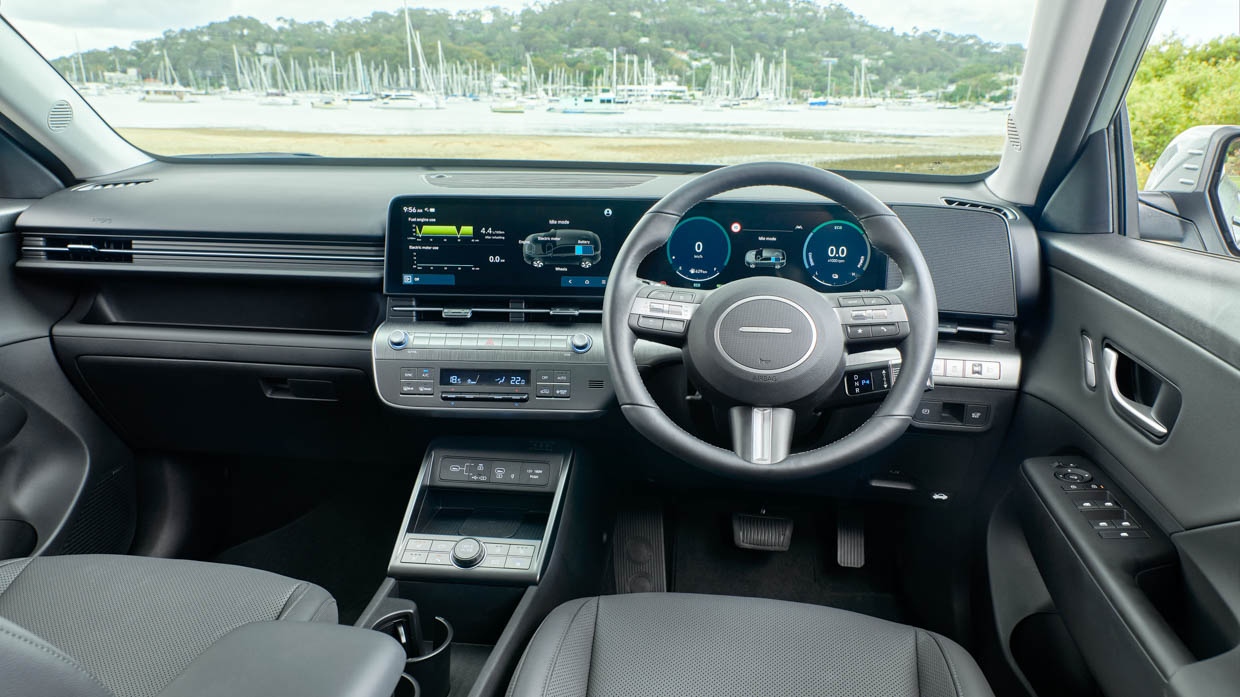
Despite the prominence of those screens, what’s appreciated is the welcome balance Hyundai strikes between modern tech and the pragmatic use of traditional functionalities.
Rather than burying most to all functions behind menus in the large touchscreen, the Kona cabin features an array of physical buttons allowing for easy shortcuts in the media system, not to mention physical dials and buttons for the climate controls.
The high volume of switchgear might seem a bit retro to anyone cross-shopping this with a screen dominated competitor, but it’s something that very much appeals to this reviewer.
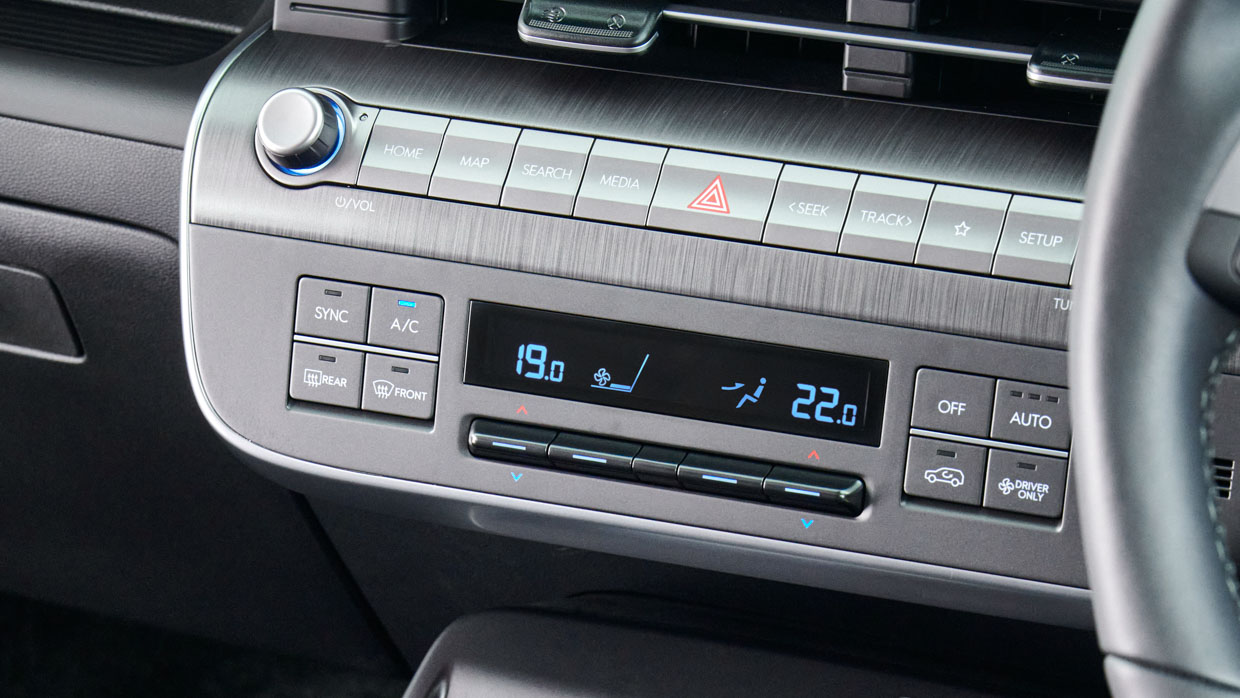
Ergonomically the cabin is sound and it’s easy to get comfortable behind the wheel. The now familiar new Hyundai steering wheel – which features four-spots which represent morse code for the letter ‘H’ instead of the traditional Hyundai logo – also feels nice in the hand.
Complementing this, the Kona sports comfy front seats which are highly electrically adjustable in the Premium spec.
Notably, the Kona Premium – like much of the modern Hyundai range – now features a shift-by-wire column mounted gear selector behind the steering wheel.
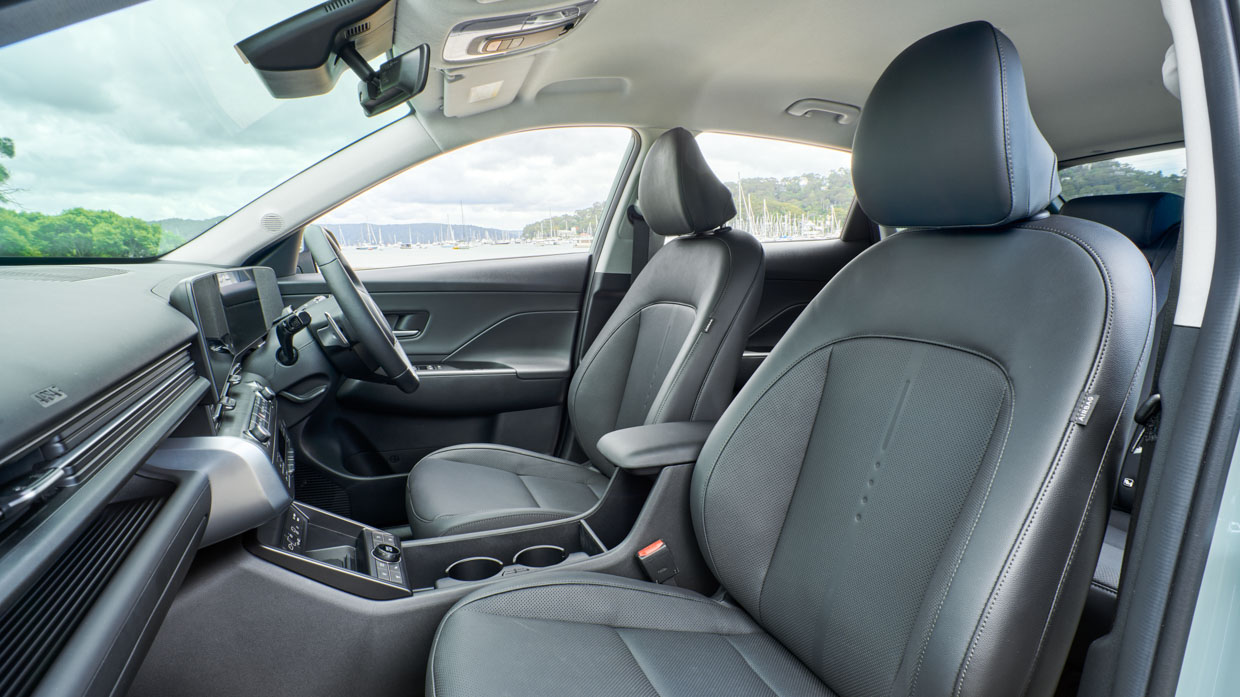
This reviewer found the gear-selector style easy to get used to and the additional space freed up in the centre console is a plus with Hyundai going for an open layout design featuring two cup holders.
That said, the centre console storage bin is almost entirely open now, with only a small top section that can be fully closed – meaning bigger items would need to go in the glovebox if you want to keep them out of view.
In terms of material quality, the cabin feels solidly screwed together and well built. This said, hard and scratchy interior plastics are present and noticeable on the front and rear doors in particular.
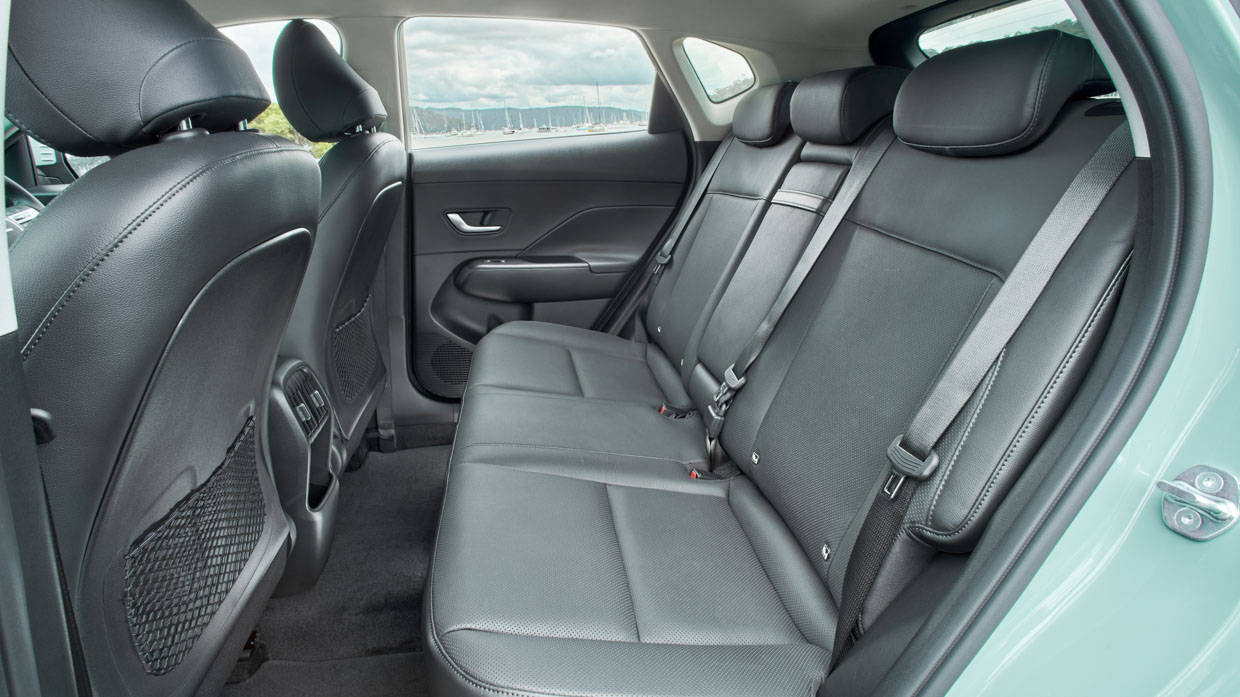
Aside from this, it’s the rear where there are noticeable benefits on the last generation with 77mm more legroom and 11mm more headroom. At 180cm, it was easy for this reviewer to get comfortable in the back of what is a spacious small SUV.
Amenities for rear seat passengers include rear air vents, two USB-C connections, map pockets, and a centre arm-rest.
There’s also more adjustability in finding the right comfort level – the rear seatbacks can be angled at 26 and 32 degrees.
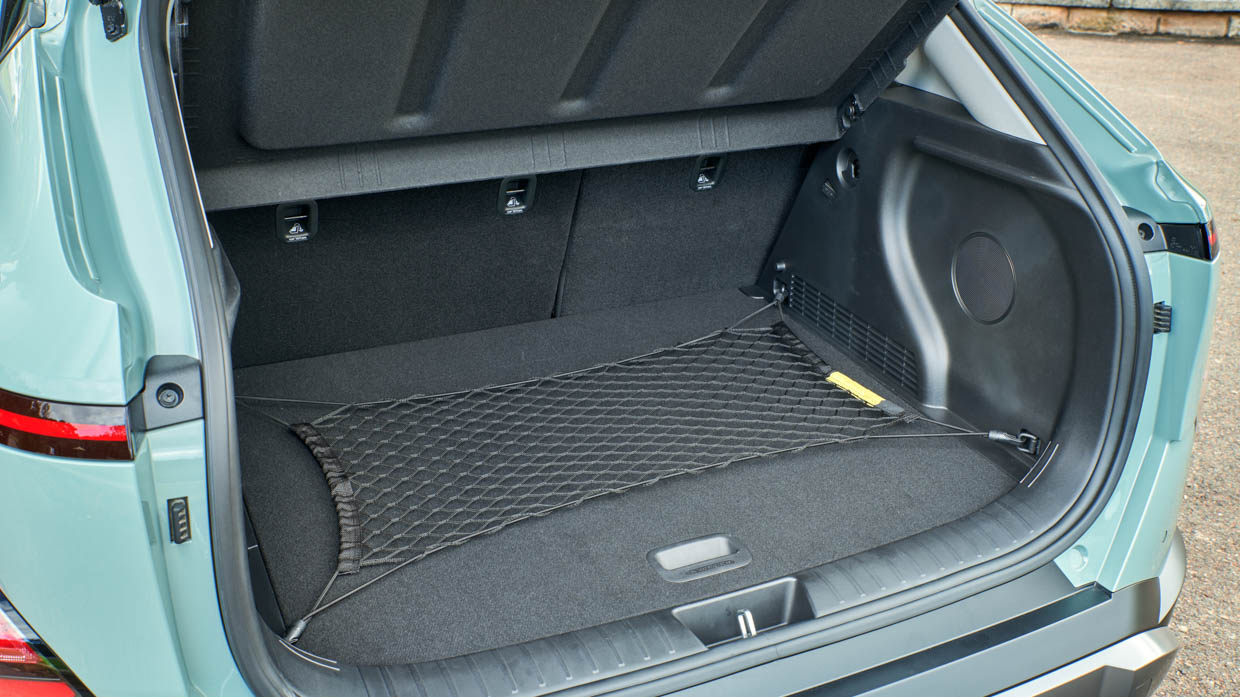
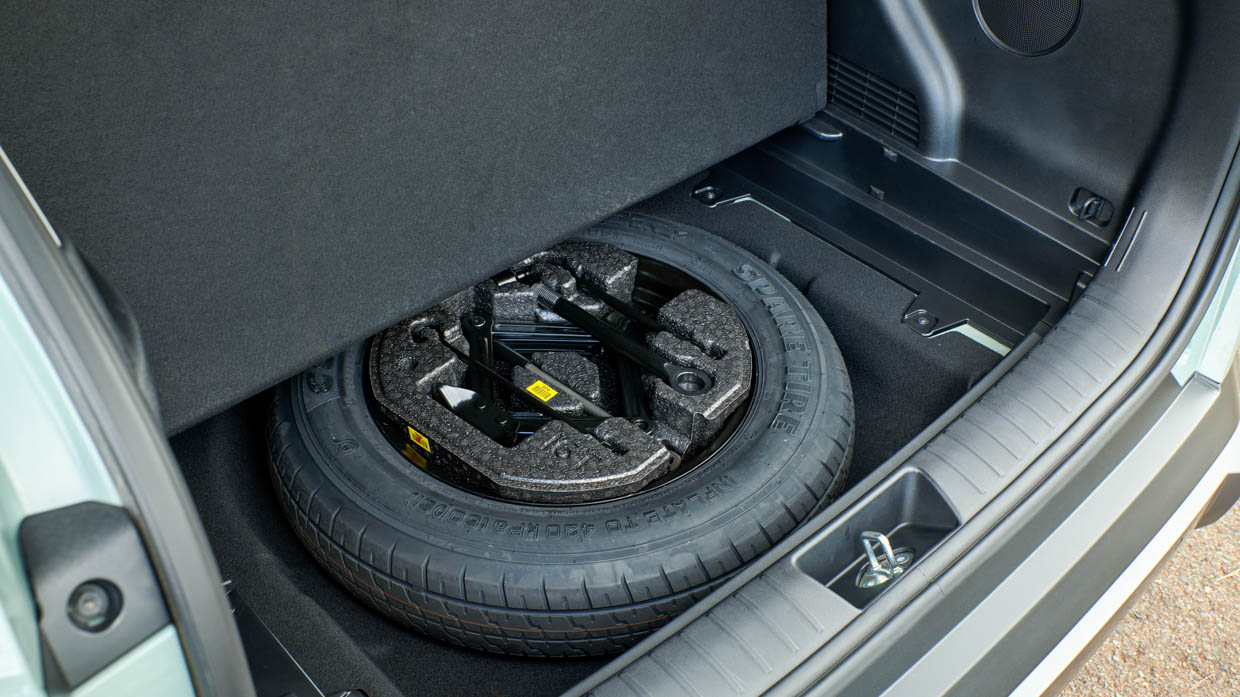
Speaking of, the seatbacks can also fold almost completely flat, unlocking a total 1241 litres of boot space when there’s no second row. Upright in their normal positions, the Kona sports 407 litres of boot space which isn’t class leading but it is solid for a small SUV, and a 33 litre increase on the previous Kona.
The boot isn’t lacking in amenities either, featuring a cargo cover, light, hooks, and a cargo net specific to the Premium. Perhaps most notably in the boot is the inclusion of a space saver spare wheel, which is always applauded in the day and age of tyre puncture repair kits.
For the most part, the pleasant interior experience delivered by the Kona Premium is echoed in the drive experience.
The front-wheel-drive hybrid, which pairs a 1.6-litre engine with an electric motor, performs at its best when driven in a relaxed and easy-going manner. Here it is quiet, delivers enough power –probably all you need – for round town cruising and darting in and out of traffic during the daily grind.
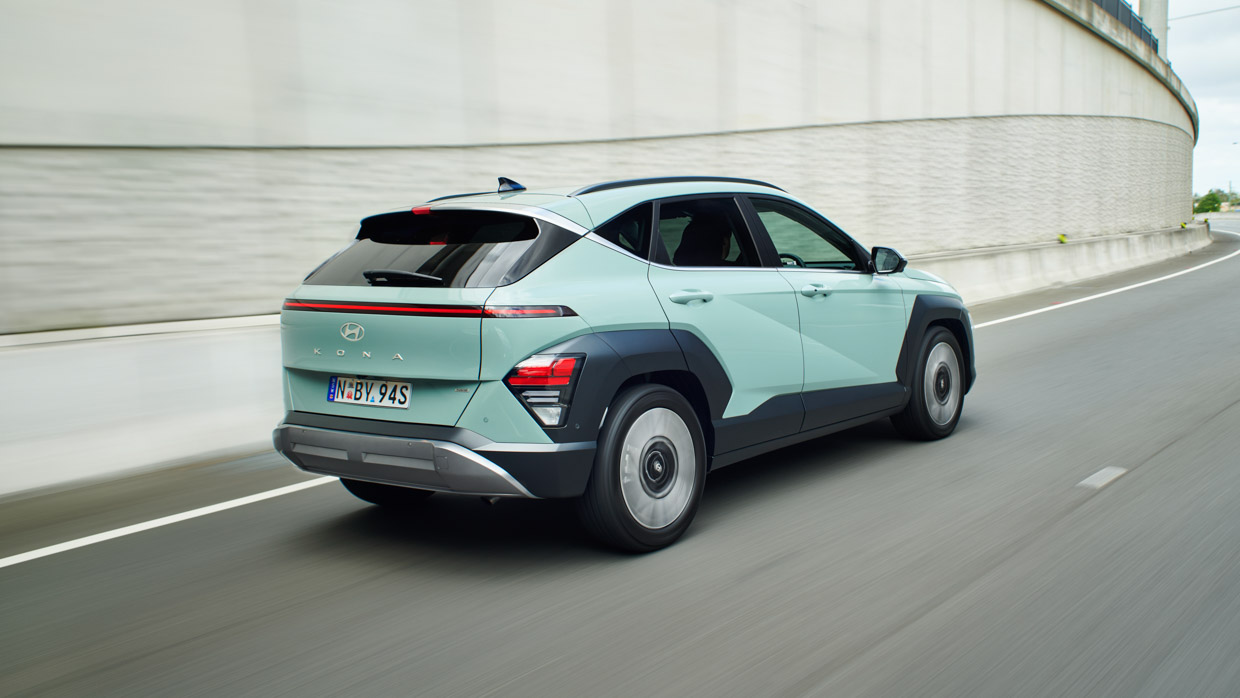
When pushed – including on high speed freeway overtakes – it’s noticeable that it’s not a firecracker of an engine. If that’s the intent you’re driving with then you may miss the more effortless shove of a turbo unit.
However, this is a hybrid small SUV after all and if a perky powertrain with a bit of extra punch is your prerogative in a small SUV, then it may be worth test driving the turbo.
Shifting the car into sport mode may help fulfill this desire to some degree, with the driver able to take command of the six-speed dry-type dual-clutch using the paddles when in sport mode.
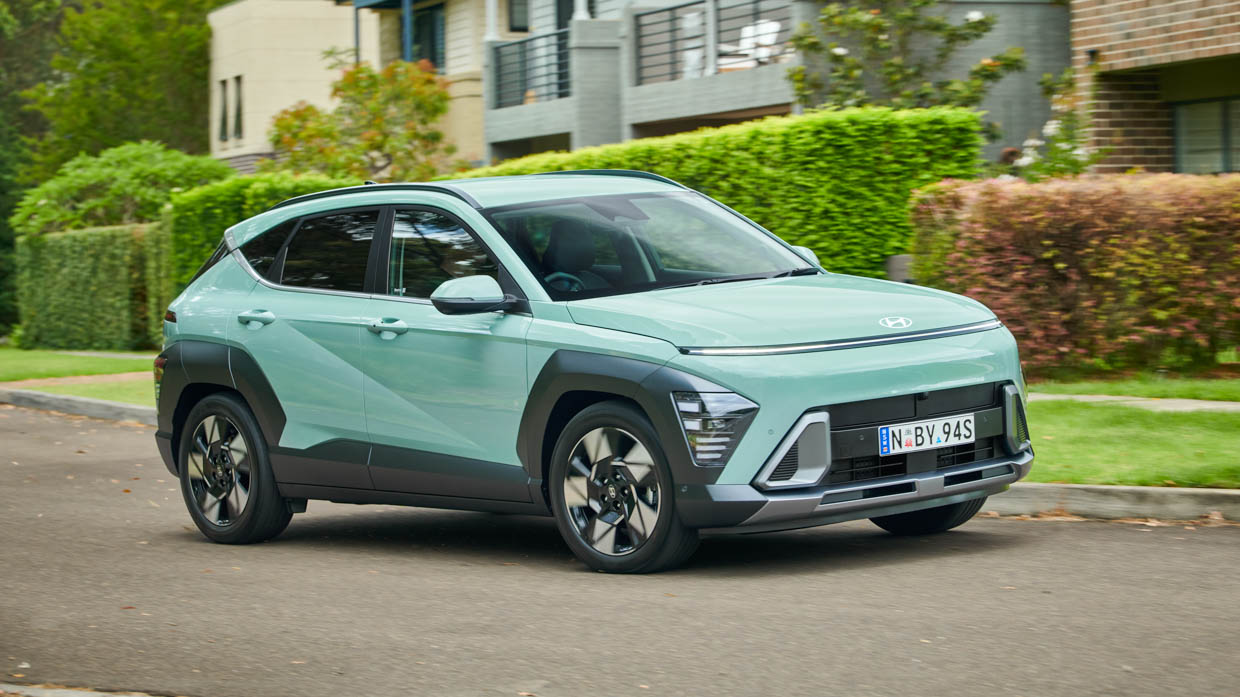
However, when out of sport mode in eco or normal mode, the paddles control the regenerative braking system available on the hybrid.
The system has four levels of intensity and a complete stop function which can stop the Kona completely using the braking of the electric motor without using the brake pedal – to activate this feature you need to pull the minus paddle-shifter for more than point four of a second.
You can also set that system to auto, which adjusts the level of regen based on the incline of the road and how the vehicle in front of you is behaving.
Again, these kinds of features go to show the intended focus of the hybrid – fuel savings and a relaxed drive experience. The Premium Hybrid is not a sports SUV, nor does it pretend or aspire to be.
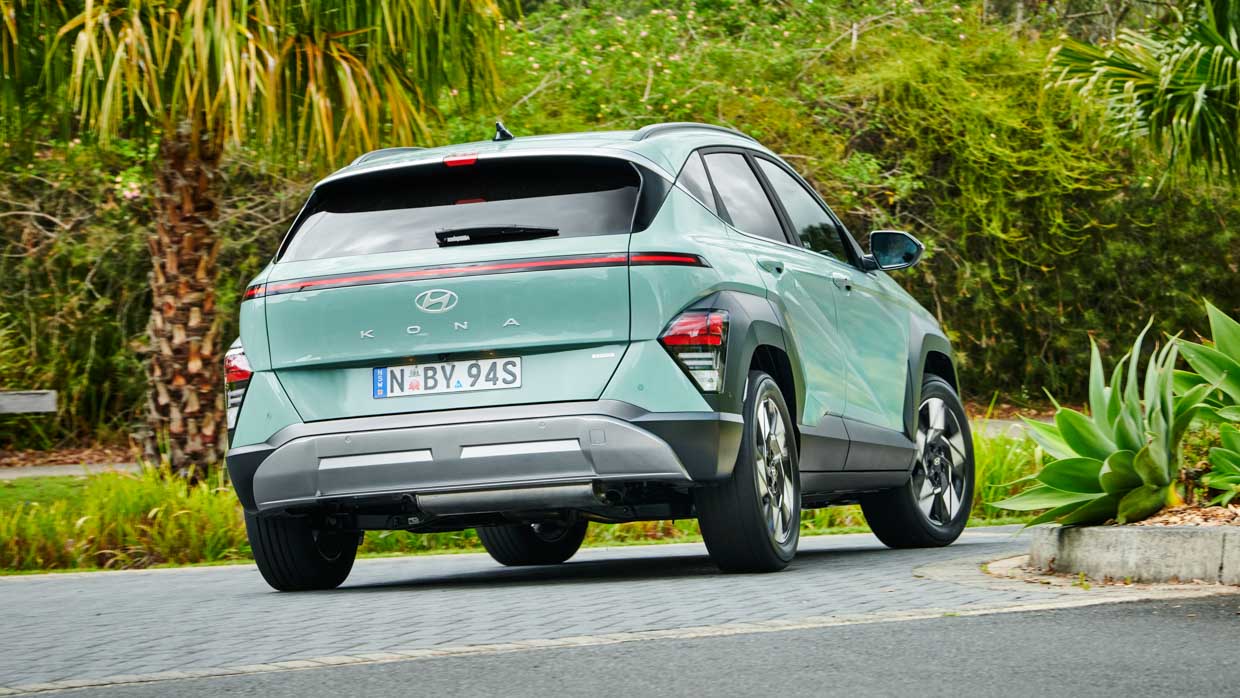
We tested the Kona Hybrid in N-Line guise around our track and delivered a peak 0-100km/h time of 9.1 seconds.
As for the ride and handling balance, this leans further toward the positive. Unlike the 2.0-litre which uses a torsion beam rear suspension set up, the Hybrid – like the N-Line turbo – gains a multi-link link rear suspension.
This makes for a grounded, well-controlled, and comfortable small SUV.
On the freeway, the Kona feels planted and secure, then on a set of twisty roads the SUV performs with decent confidence and composure when pushed a little harder than it’s probably intended.
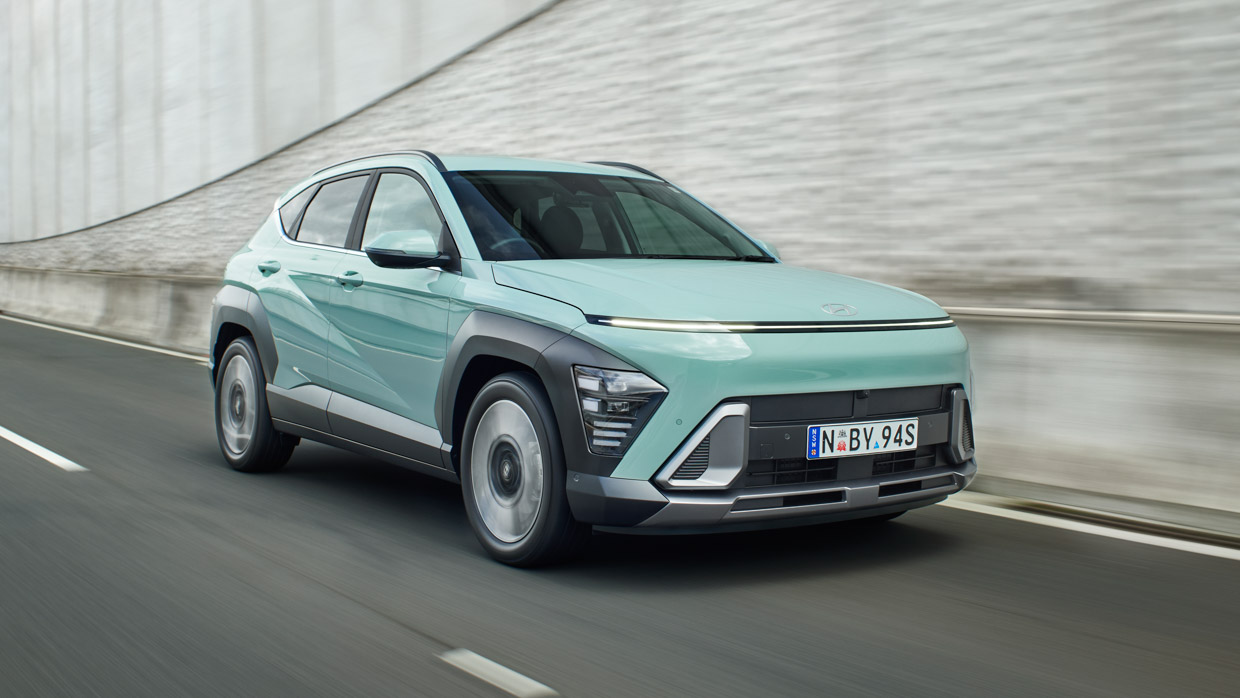
Also notable in this regard is Hyundai’s e-DTVC (electric dynamic torque vectoring control) system which is standard and exclusive to the hybrid only.
It’s intended to minimise understeer during cornering by partially braking the wheel on the side of a corner while also driving additional motor torque to the outside wheel.
As for ride, the Kona Hybrid delivers a quality ride that’s not plush but it’s compliant and absorbent enough to take the edge off bumps and imperfections in a manner that adds to an overall very comfortable drive experience.
The steering is also light and natural, making for a car that’s easy to pilot and place exactly where you want on the road.
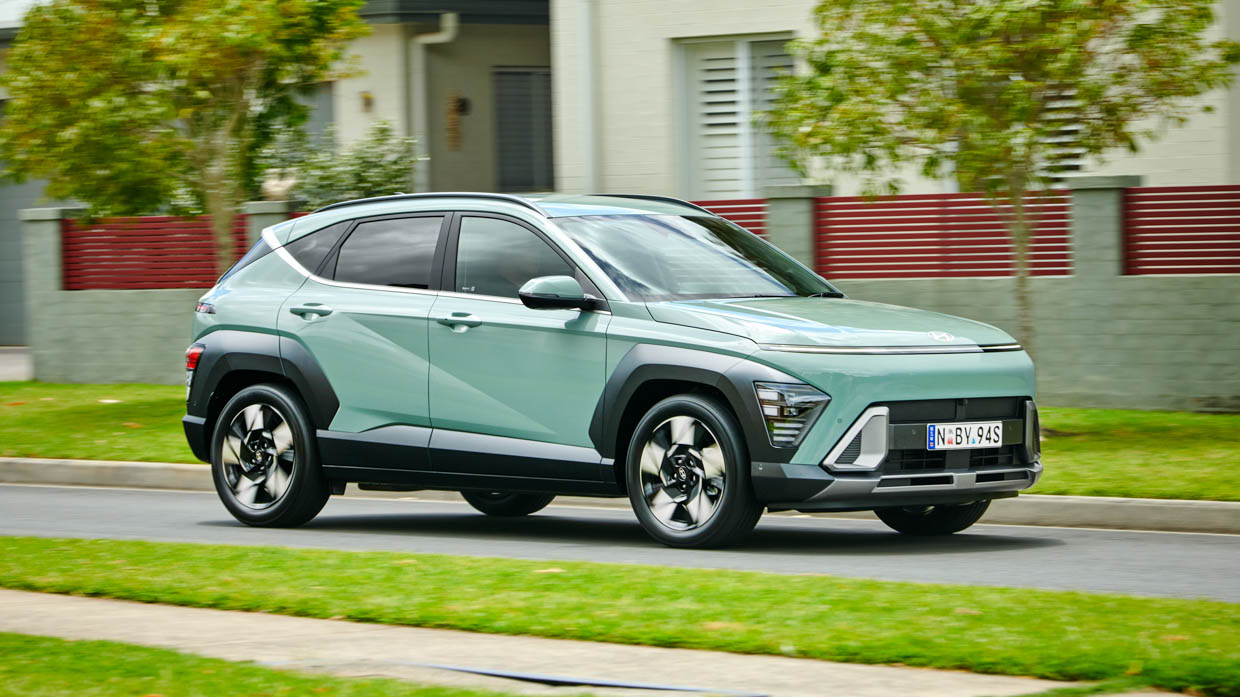
Coupled with this, the brakes feel solid and natural under foot and deliver adequate stopping power.
We tested braking performance on our track and delivered a strong peak result of 33.83 metres for the 100km/h to zero brake test, which is quite impressive.
However, what takes away from the drive experience won’t come as a surprise to anyone who has read or watched our review of the pure-petrol variants of the new Kona.
The Kona Hybrid Premium should on one hand be commended for its safety features, some of which are detailed below:
As listed earlier, the Premium also gains Hyundai SmartSense including Blind-Spot Monitor, Parking Collision Avoidance Assist-Reverse, 3D Surround View Monitor.
The blind-spot monitor view is a welcome feature in particular, and it integrates the camera vision into the clean digital instrument display nicely.
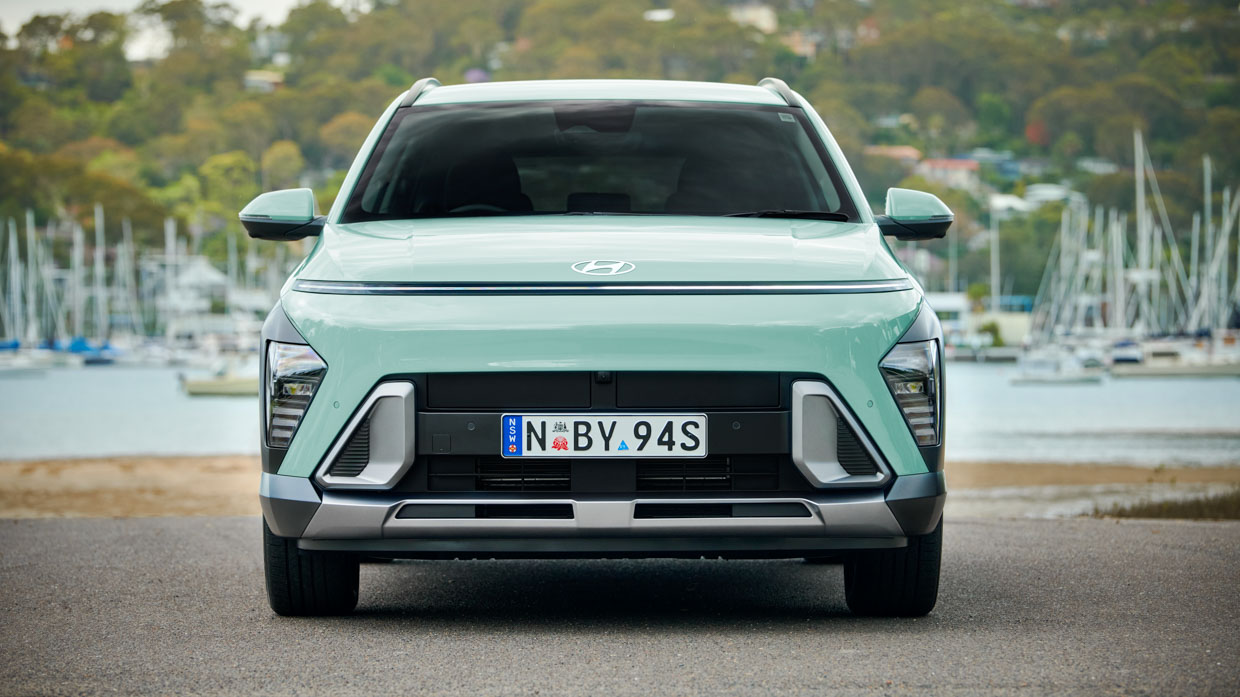
What’s less nicely integrated are some of the over-zealous safety features which on one hand are tuned to maximum safety, but on the other – maximum annoyance.
The lane-keep assist didn’t seem too intrusive during my time with the Kona, though I did have it switched off for much of the drive – which was at least relatively easy to do through the press of an easy to access button on the steering wheel.
What’s harder to turn off quickly and easily are the speed limit monitor warnings and driver-attention alert, which was indeed a point mentioned in our previous Kona review.
The audible speed limit warnings which sound at a smidge of one kilometre-per-hour over the speed limit can get frustrating, as do the persistent chimes that sound if the driver alert monitor camera deems that you’ve taken your eyes off the road for too long – making it very difficult to look at necessary digital instruments in front of you without being pinged.
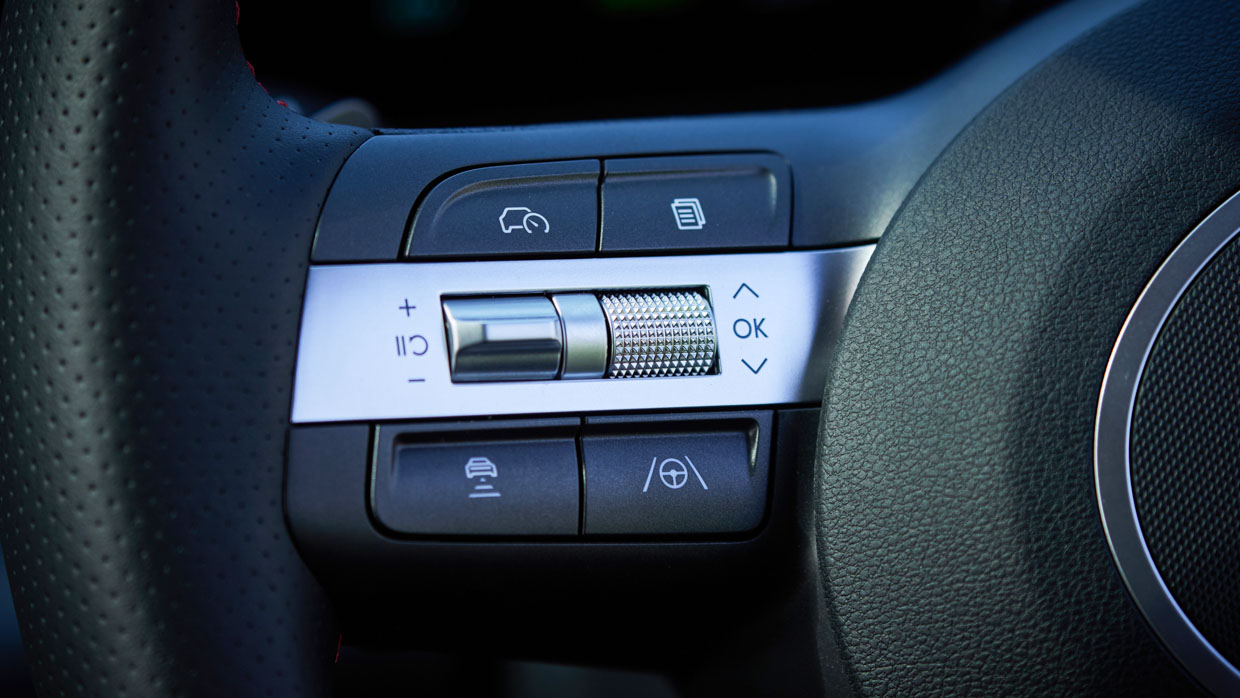
To switch either off you need to make your way through multiple settings in the media display screen, although you can set up shortcuts to minimise the amount of steps you need to go through .
If you’re someone who will be doing this day in and day out, it’s those extra seconds each day – and every time you start the car – that will add up across the years.
The new Kona hasn’t yet been crash tested by ANCAP.
Servicing the Hyundai Kona hybrid Premium will set you back $399 per service, with each scheduled to come in at every 12 months or every 15,000 kilometres. Across five years that will set you back $1995.
The vehicle is covered by Hyundai’s five-year/unlimited-kilometre warranty, with an eight-year/160,000-kilometre warranty for the electric battery.
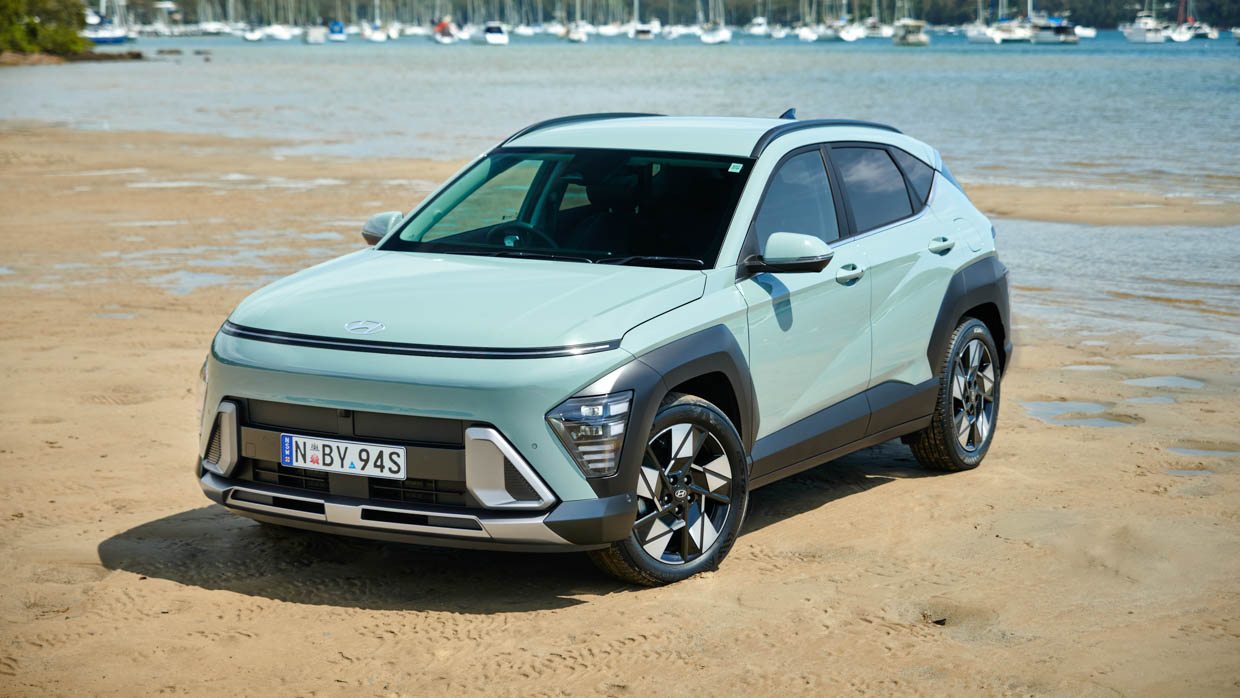
However, perhaps the most important ownership cost at all for the Hybrid Premium – fuel consumption, which Hyundai claims as 3.9 litres per hundred kilometres.
During my time with the car I averaged between 4.0 and 4.7 litres, which mainly consisted of freeway and suburban driving.
So are the fuel efficiency gains worth it for the $4000 premium? Well, in our view, based on fuel efficiency alone, yes.
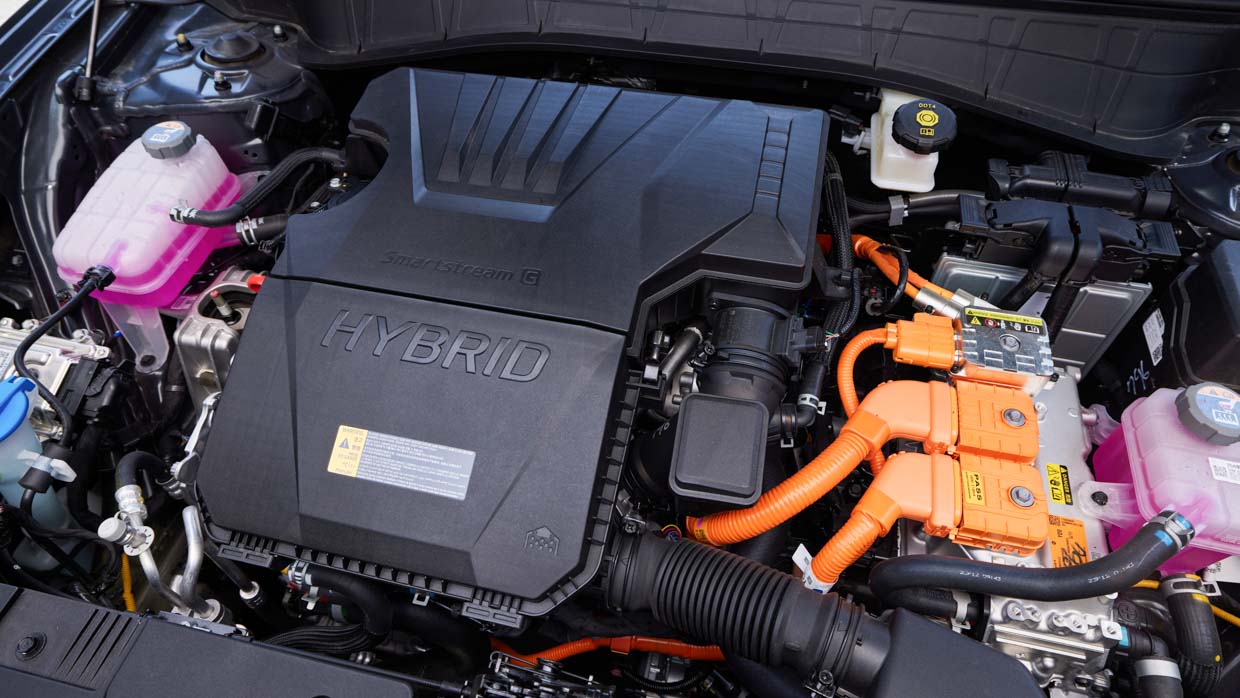
Comparing claimed fuel efficiency between the three petrol-powered Konas, we can see that the Hybrid (3.9L/100km) uses 41 percent less fuel than the 2.0-litre (6.6L/100km) and 49 percent less than the 1.6-litre turbo (7.6L/100km).
Based on an average cost of fuel of two dollars per litre (chosen for calculation simplicity), that will by and large save you $4000 over five years – effectively making back the premium you pay for the hybrid.
More significantly, the saving equates to $5500 over the same length of time compared to the least fuel efficient 1.6-litre turbo. That’s particularly noteworthy given the Hybrid and 1.6-litre turbo cost the same when the hybrid is specified with the N-line package too.
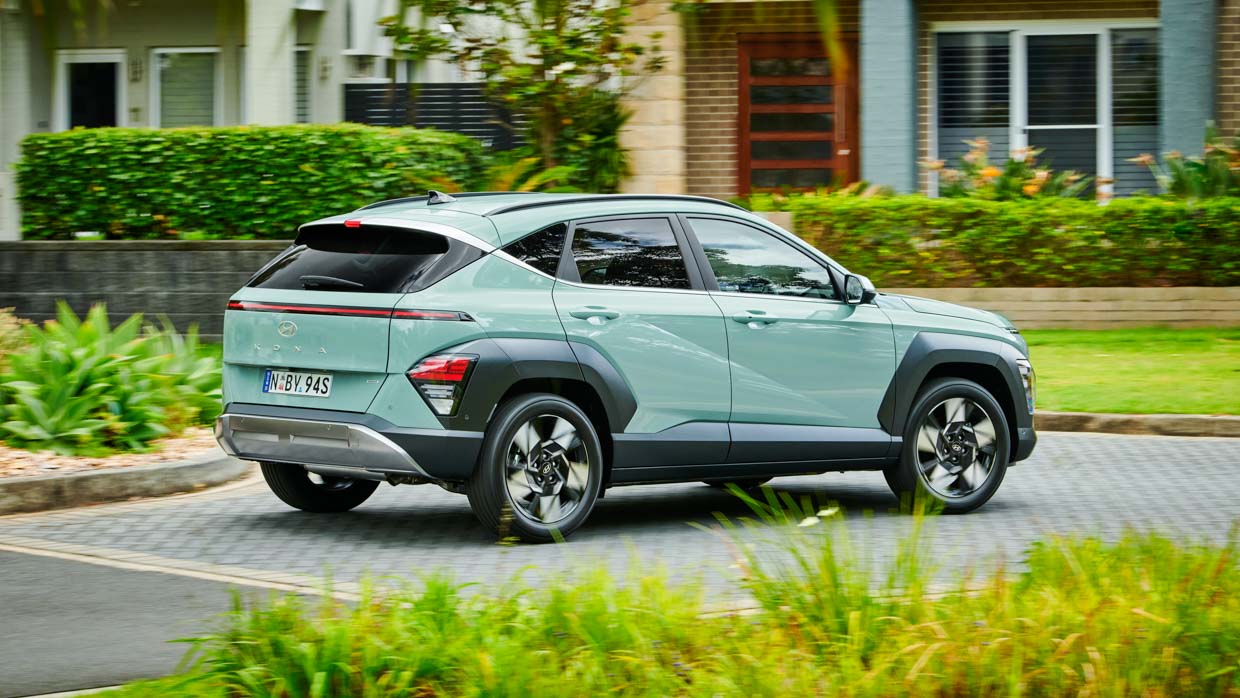
If you eliminate the upcharge of the N-Line package – as is the case in this Hybrid Premium – that saving becomes even more significant.
This also doesn’t account for the extra features you get for the Hybrid over the 2.0-litre or 1.6-litre turbo that we referenced earlier.
So is the Kona Hybrid Premium the sweet spot in the Kona range?
This ultimately depends on your use case and preferences. It’s a highly competent, well equipped, comfortable and generally refined driving experience.
There is a segment of buyers that may be wanting for more power and verve in the powertrain.
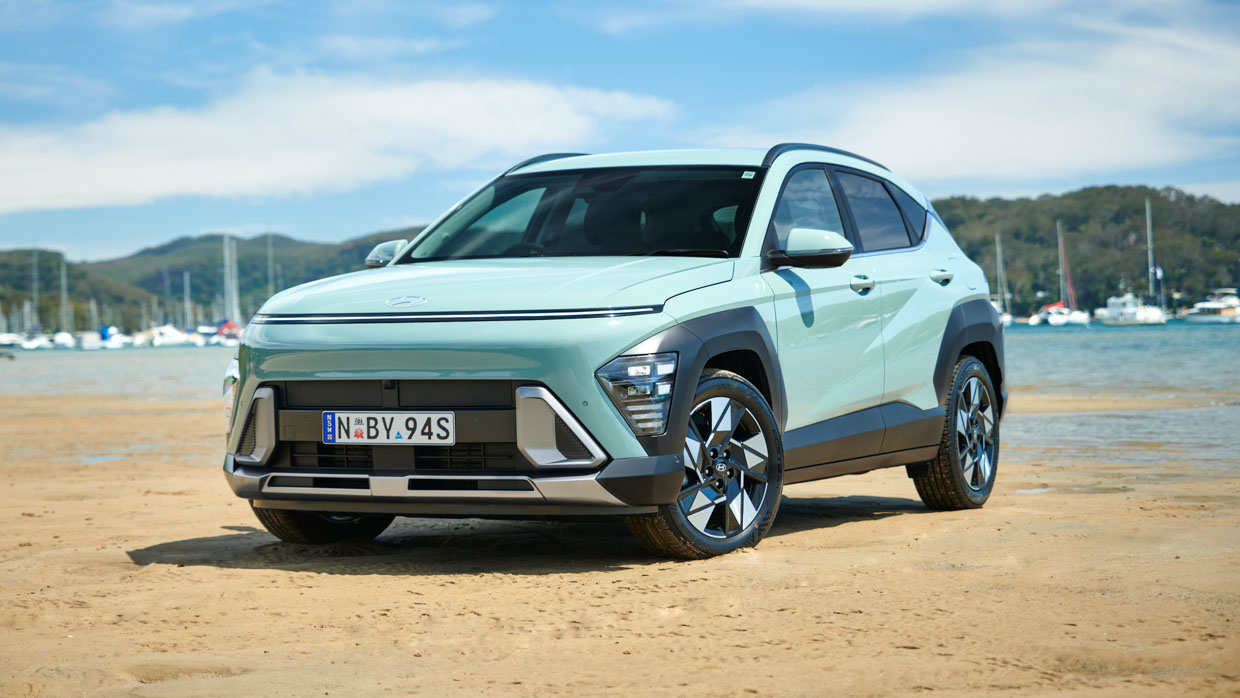
But those who are looking for a highly efficient, relaxed and well-driving experience and one that couples a blend of funky styling (at least to this reviewer’s eyes) should be pleased here with Kona, if they can come to terms with the over-zealous safety features.
This said, we can’t make a full range verdict assessment until we’ve driven and looked at the range in context of the electric Kona. That result will also hinge on how the electric is priced and this remains to be seen until later in the year.
For now at least – given the high penetration of Kona sales – and the well-rounded package it offers in its new Premium Hybrid form, it seems ‘Kona’ may indeed be the new default response when we next play our next round of Hyundai word association…
Key specs (as tested)
About Chasing cars
Chasing Cars reviews are 100% independent.
Because we are powered by Budget Direct Insurance, we don’t receive advertising or sales revenue from car manufacturers.
We’re truly independent – giving you Australia’s best car reviews.
The estimate provided does not take into account your personal circumstances but is intended to give a general indication of the cost of insurance, in order to obtain a complete quote, please visit www.budgetdirect.com.au. Estimate includes 15%^ online discount.
^Conditions Apply
Budget Direct Insurance arranged by Auto & General Services Pty Ltd ACN 003 617 909(AGS) AFSL 241 411, for and on behalf of the insurer, Auto & General Insurance Company Limited(ABN 42 111 586 353, AFSL 285 571).Because we don’t know your financial needs, we can’t advise you if this insurance will suit you. You should consider your needs and the Product Disclosure Statement before making a decision to buy insurance. Terms and conditions apply.
Indicative quote based on assumptions including postcode , 40 year old male with no offences, licence suspensions or claims in the last 5 years, a NCD Rating 1 and no younger drivers listed. White car, driven up to 10,000kms a year, unfinanced, with no modifications, factory options and/or non-standard accessories, private use only and garaged at night.
^Online Discounts Terms & Conditions
1. Discounts apply to the premium paid for a new Budget Direct Gold Comprehensive Car Insurance, Third Party Property Only or Third Party Property, Fire & Theft Insurance policy initiated online on or after 29 March 2017. Discounts do not apply to optional Roadside Assistance.
2. Discounts do not apply to any renewal offer of insurance.
3. Discounts only apply to the insurance portion of the premium. Discounts are applied before government charges, taxes, levies and fees, including instalment processing fees (as applicable). The full extent of discounts may therefore be impacted.
4. We reserve the right to change the offer without notice.